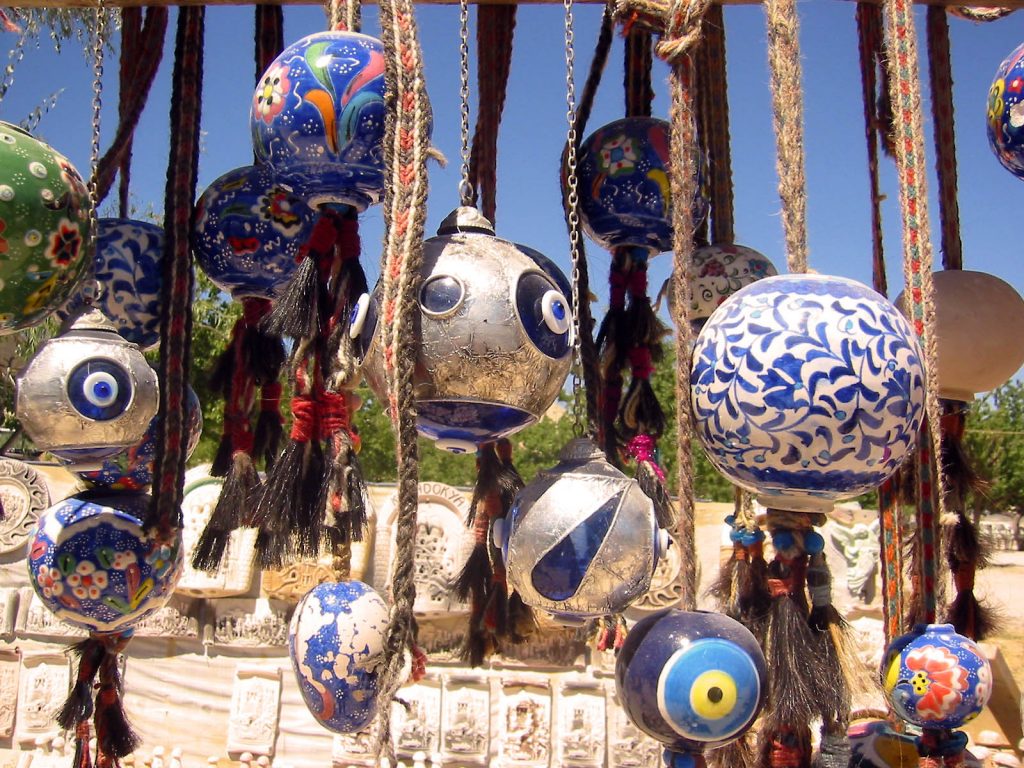As I was flipping the channels the other day, I saw a teleshopping ad for Suraksha kavach (or evil eye protection). Though I am familiar with the concept, I was wanted to learn more about it, especially its application in other countries.
Evil Eye beads
Evil Eye symbol or Surakasha Kavach has been worn (incorporated into mainstream jewelry) around the world. By wearing one a person who is beautiful or well dressed will not attract any negative vibrations. The Evil Eye beads works under the philosophy of “an eye for an eye”. It cancels negativity and evil with an ever-gazing eye bead staring right back, thus turning evil away providing comfort and assurance of positive thoughts to the wearer. Here are some evil eye beads from around the world.
DZi beads
In Tibet and Mesopotamia, agate gemstones etched eye symbols, zigzags and wave-patterns are referred to as DZi (pronounced Zee) beads. A bead with “nine eyes” is the most desired. In ancient Egypt, there is the eye of Horus known as the udjat (pronounced ut-chat).
Cowie shells & Meenakari
In Indian and Africa Cowie shells are believed to represent the human eye and are valued as protection against evil. It is also said that Rajasthani princess wore ornate meenakari pieces with a stone (eye in the center over concentric color circles) for the same reason.
Glass Evil Eye beads
Blue colored Moroccan, Turkish and Greek eye beads are still seen in modern-day homes as danglers at the entrance. The Warring States era of China brought the famous glass horned-eye beads with their horn-like bumps made of colorful concentric layers of bull’s-eye dots.
Gemstones for protection
Even gemstone beads, such as tiger’s eye and red coral, have been valued for averting the evil eye. Because of the chatoyant quality of tiger’s eye beads, it is believed that these beads are capable of spotting evil from all directions at once. The most common protective jewelry for pregnant and nursing mothers is a branch of red coral worn as a pendant. This is why coral beads and black beads form a part of our Indian Mangal sutra.
Other symbols
The hand of Hamsa, also known as the hand of Kamsa, Fatima or Miriam is another symbol that is used. In Turkey it is called “Nazar Boncugu”. Native Americans believed in embedding the symbol called Ovoid eyes on carvings, brightly colored paintings on totems, masks and blankets portraying animals as they believed that living in closer harmony with nature would protect them from evil and mischief.
Fascinating, isn’t it? These eye beads remind us that gemstone and jewelry have always been more than adornment, style or fashion. They could have a deeper meaning to protect and preserve life. Even though we might live on different continents and follow different traditions, our core thoughts that bind us together as people are always the same. Evil eye beads can be used to make almost any kind of jewelry but bracelets and wristbands are the most common. Find here a tutorial to make a simple evil eye bracelet.
Article originally published on Sulekha. Picture courtesy: firemountaingems
I hope you find it interesting
Cheers



